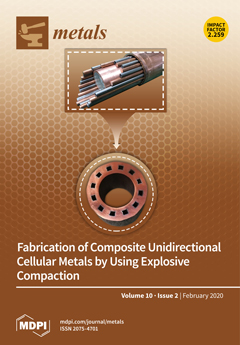The in situ reaction method for preparing metal matrix composites has the advantages of a simple process, good combination of the reinforcing phase and matrix, etc. Based on the mechanism of forming TiC
x particles via the dissolution reaction of solid carbon (C)
[...] Read more.
The in situ reaction method for preparing metal matrix composites has the advantages of a simple process, good combination of the reinforcing phase and matrix, etc. Based on the mechanism of forming TiC
x particles via the dissolution reaction of solid carbon (C) particles in Cu-Ti melt, the kinetic models for C particle dissolution reaction were established. The kinetic models of the dissolution reaction of spherical, cylindrical, and flat C source particles in Cu-Ti melt were deduced, and the expressions of the time for the complete reaction of C source particles of different sizes were obtained. The mathematical relationship between the degree of reaction of C source and the reaction time was deduced by introducing the shape factor. By immersing a cylindrical C rod in a Cu-Ti melt and placing it in a super-gravity field for the dissolution reaction, it was found that the super-gravity field could cause the precipitated TiC
x particles to aggregate toward the upper part of the sample under the action of buoyancy. Therefore, the consuming rate of the C rod was significantly accelerated. Based on the flat C source reaction kinetic model, the relationship between the floating speed of TiC
x particles in the Cu-Ti melt and the centrifugal velocity (or the coefficient of super-gravity
G) was derived. It was proven that, when the centrifugal velocity exceeded a critical value, the super-gravity field could completely avoid the accumulation behavior of TiC
x particles on the surface of the C source, thereby speeding up the formation reaction of TiC
x. The goal of this study is to better understand and evaluate the generating process of TiC
x particles, thus finding possible methods to increase the reaction efficiency
Full article





